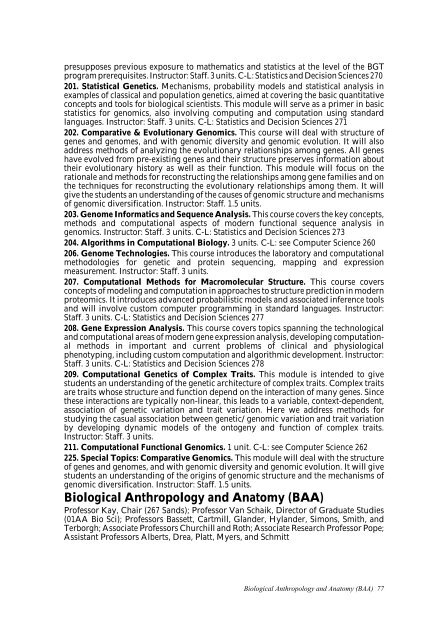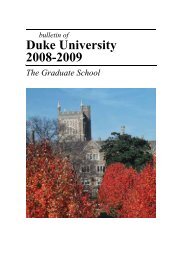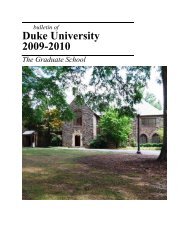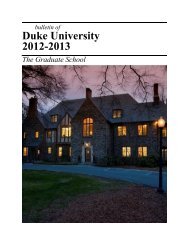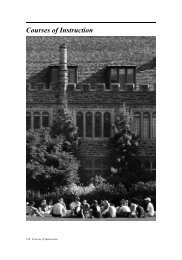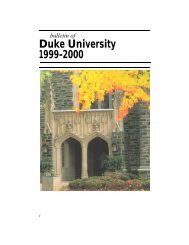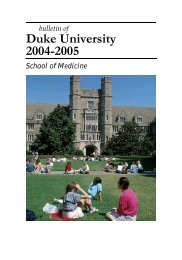Duke University 2003-2004 - Office of the Registrar - Duke University
Duke University 2003-2004 - Office of the Registrar - Duke University
Duke University 2003-2004 - Office of the Registrar - Duke University
Create successful ePaper yourself
Turn your PDF publications into a flip-book with our unique Google optimized e-Paper software.
presupposes previous exposure to ma<strong>the</strong>matics and statistics at <strong>the</strong> level <strong>of</strong> <strong>the</strong> BGT<br />
program prerequisites. Instructor: Staff. 3 units. C-L: Statistics and Decision Sciences 270<br />
201. Statistical Genetics. Mechanisms, probability models and statistical analysis in<br />
examples <strong>of</strong> classical and population genetics, aimed at covering <strong>the</strong> basic quantitative<br />
concepts and tools for biological scientists. This module will serve as a primer in basic<br />
statistics for genomics, also involving computing and computation using standard<br />
languages. Instructor: Staff. 3 units. C-L: Statistics and Decision Sciences 271<br />
202. Comparative & Evolutionary Genomics. This course will deal with structure <strong>of</strong><br />
genes and genomes, and with genomic diversity and genomic evolution. It will also<br />
address methods <strong>of</strong> analyzing <strong>the</strong> evolutionary relationships among genes. All genes<br />
have evolved from pre-existing genes and <strong>the</strong>ir structure preserves information about<br />
<strong>the</strong>ir evolutionary history as well as <strong>the</strong>ir function. This module will focus on <strong>the</strong><br />
rationale and methods for reconstructing <strong>the</strong> relationships among gene families and on<br />
<strong>the</strong> techniques for reconstructing <strong>the</strong> evolutionary relationships among <strong>the</strong>m. It will<br />
give <strong>the</strong> students an understanding <strong>of</strong> <strong>the</strong> causes <strong>of</strong> genomic structure and mechanisms<br />
<strong>of</strong> genomic diversification. Instructor: Staff. 1.5 units.<br />
203. Genome Informatics and Sequence Analysis. This course covers <strong>the</strong> key concepts,<br />
methods and computational aspects <strong>of</strong> modern functional sequence analysis in<br />
genomics. Instructor: Staff. 3 units. C-L: Statistics and Decision Sciences 273<br />
204. Algorithms in Computational Biology. 3 units. C-L: see Computer Science 260<br />
206. Genome Technologies. This course introduces <strong>the</strong> laboratory and computational<br />
methodologies for genetic and protein sequencing, mapping and expression<br />
measurement. Instructor: Staff. 3 units.<br />
207. Computational Methods for Macromolecular Structure. This course covers<br />
concepts <strong>of</strong> modeling and computation in approaches to structure prediction in modern<br />
proteomics. It introduces advanced probabilistic models and associated inference tools<br />
and will involve custom computer programming in standard languages. Instructor:<br />
Staff. 3 units. C-L: Statistics and Decision Sciences 277<br />
208. Gene Expression Analysis. This course covers topics spanning <strong>the</strong> technological<br />
and computational areas <strong>of</strong> modern gene expression analysis, developing computational<br />
methods in important and current problems <strong>of</strong> clinical and physiological<br />
phenotyping, including custom computation and algorithmic development. Instructor:<br />
Staff. 3 units. C-L: Statistics and Decision Sciences 278<br />
209. Computational Genetics <strong>of</strong> Complex Traits. This module is intended to give<br />
students an understanding <strong>of</strong> <strong>the</strong> genetic architecture <strong>of</strong> complex traits. Complex traits<br />
are traits whose structure and function depend on <strong>the</strong> interaction <strong>of</strong> many genes. Since<br />
<strong>the</strong>se interactions are typically non-linear, this leads to a variable, context-dependent,<br />
association <strong>of</strong> genetic variation and trait variation. Here we address methods for<br />
studying <strong>the</strong> casual association between genetic/genomic variation and trait variation<br />
by developing dynamic models <strong>of</strong> <strong>the</strong> ontogeny and function <strong>of</strong> complex traits.<br />
Instructor: Staff. 3 units.<br />
211. Computational Functional Genomics. 1 unit. C-L: see Computer Science 262<br />
225. Special Topics: Comparative Genomics. This module will deal with <strong>the</strong> structure<br />
<strong>of</strong> genes and genomes, and with genomic diversity and genomic evolution. It will give<br />
students an understanding <strong>of</strong> <strong>the</strong> origins <strong>of</strong> genomic structure and <strong>the</strong> mechanisms <strong>of</strong><br />
genomic diversification. Instructor: Staff. 1.5 units.<br />
Biological Anthropology and Anatomy (BAA)<br />
Pr<strong>of</strong>essor Kay, Chair (267 Sands); Pr<strong>of</strong>essor Van Schaik, Director <strong>of</strong> Graduate Studies<br />
(01AA Bio Sci); Pr<strong>of</strong>essors Bassett, Cartmill, Glander, Hylander, Simons, Smith, and<br />
Terborgh; Associate Pr<strong>of</strong>essors Churchill and Roth; Associate Research Pr<strong>of</strong>essor Pope;<br />
Assistant Pr<strong>of</strong>essors Alberts, Drea, Platt, Myers, and Schmitt<br />
Biological Anthropology and Anatomy (BAA) 77


